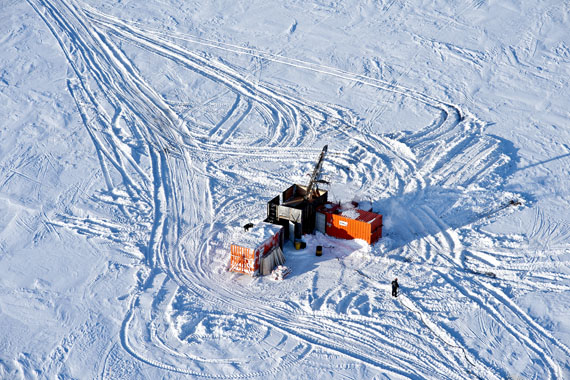Mining company says impacts of Nunavut mine will be good, bad
Meliadine gold mine expected to be operational by 2019

A drilling crew does exploration work at the Meliadine site several years ago. (FILE PHOTO)
Nearly half a century after gold was first discovered at Meliadine Lake, Agnico Eagle Mines is hoping soon to start digging it out of the ground and, with the May release of its final environmental impact statement, it got a little closer to that goal.
Agnico Eagle Mines, which operates Nunavut’s only operating mine — a gold operation at Meadowbank about 80 kilometres north of Baker Lake — outlines in the final EIS what it anticipates will be the impact of gold production on the vegetation, air quality, sea and land animals, and also nearby people.
Within many hundreds of pages — typical for these kinds of reports, which must describe fully the scope of the project as well as how they plan to monitor and mitigate the impacts— the company is hoping to reassure the Nunavut Impact Review Board, and Nunavummiut, that the benefits of such a mine outweigh any potential impacts.
“Mining development is expected to be the largest economic driver in the coming years,” the report says, while noting that currently, much of the economy in the Kivalliq region is based on “subsistence hunting, trapping and fishing.”
That means an economic transformation, already under way since the opening of the Meadowbank gold mine in 2010, is about to accelerate on the western shores of Hudson Bay.
The report suggests the impacts of Meliadine, which the company hopes will be operating by 2019, will be both negative and positive.
The all-weather road between Meliadine and Rankin Inlet, completed in 2013, will increase access to harvesting, the study says; well-paying mine jobs will have a positive impact on the economy; and, the project is likely “to build capacity through learning and should influence education and training opportunities in Nunavut in a constructive way.”
However, “potential effects on individual, family and community well-being are complex, far reaching and unpredictable,” the report says.
“It is noted that there will be an adjustment period during which negative effects may be expected until people learn to manage life changes associated with wage employment, such as income, diet and nutrition, and stresses.”
It hints at the toll the project may take as people in the communities adapt to this transformation.
“The effect of the project on social and police services in the local service area is considered to be negative due to the potential for increased crime,” the report says.
The final EIS also talks about the impact the project will have on wildlife such as birds, fish and caribou.
The Meliadine mine will be located within the range of the Qamanirjuaq caribou herd, a prime food source for Kivallirmiut.
According to the Beverly and Qamanirjuaq Caribou Management Board, the herd comprised 348,000 animals in 2008.
Their range straddles the Manitoba and Nunavut boundaries with portions in southeastern Northwest Territories and northeastern Saskatchewan.
The caribou management board website shows the traditional calving grounds within about 50 kilometres of the proposed Meliadine mine.
In fact, on May 20, the caribou board issued a news release urging the Nunavut Planning Commission to prohibit all land use activities in calving and post-calving areas, fearing the cumulative impact of mining exploration and development in the herd’s range.
“Development in areas where caribou calve and nurse their young is disrespectful and dangerous, and will hurt the caribou, which will then hurt Inuit,” said Arviat hunter Leo Ikakhik, in the board’s news release.
The board stressed that it is not against development, only in caribou calving and post-calving areas.
Agnico Eagle says in its final EIS that, according to Government of Nunavut studies, some caribou have moved through or near the mine site area in recent years, including during the post-calving and late summer seasons.
The herd will likely lose 33,402 hectares of habitat due to “existing and future developments,” the report says, and about 14,412 hectares of habitat due to sensory disturbances such as traffic.
But as with many disturbances, the report says the effects are “expected to be reversible in the long-term.”
The company predicts habitat loss and fragmentation, and sensory disturbances will have an impact on bird, water fowl and raptor populations, but again, “all effects are expected to be reversible in the long-term,” it says.
While the company predicts no significant adverse impact on fish, it does suspect there will be an impact on marine wildlife in relation to “habitat loss, habitat quality, sensory disturbance, spills, and collisions with ships from the project.”
This too, the company says, will be “reversible in the short- to long-term.”
Meliadine is located roughly 25 km from Rankin Inlet and 80 km southwest of Chesterfield. The deposits are largely located on Inuit-owned lands.
While Rankin Inlet, as a regional hub, would experience the most impact, the study identifies Chesterfield Inlet, Whale Cove, Baker Lake and Arviat as part of the “local study area.”
The company outlines how people and services in that area will be effected once the mine is up and running and that includes impacts on schools, police services, the health care system and on local businesses.
In order to measure the environmental impact of the mine, the company has collected what’s called “baseline data” on everything from noise levels to ice thickness and terrestrial wildlife.
That means when they measure impacts in future, after the mine is up and running, they will have comparison data.
The mine expects to employ 1,000 workers during the three-year construction phase of the project and 700 for mine operations, with 350 people on-side at any given time.
According to project description, the mine comprises five deposits, which will be mined using conventional open pit and underground methods.
As of December 2013, the proven and probable reserves were 2.8 million ounces of gold. Gold bars will be smelted on site.
Over the projected life of the mine, anticipated at 13 years, the project is estimated to generate roughly $5.9 billion in revenue.
Project-related shipping will operate out of Melvin Bay, just south of Rankin Inlet.





(0) Comments